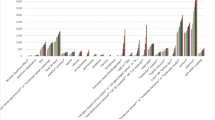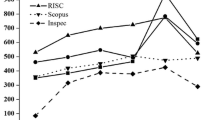Abstract
Nanoscience and technology (NST) is a relatively new interdisciplinary scientific domain, and scholars from a broad range of different disciplines are contributing to it. However, there is an ambiguity in its structure and in the extent of multidisciplinary scientific collaboration of NST. This paper investigates the multidisciplinary patterns of Iranian research in NST based on a selection of 1,120 ISI—indexed articles published during 1974–2007. Using text mining techniques, 96 terms were identified as the main terms of the Iranian publications in NST. Then the scientific structure of the Iranian NST was mapped through multidimensional scaling, based upon the co-occurrence of the main terms in the academic publications. The results showed that the NST domain in Iranian publications has a multidisciplinary structure which is composed of different fields, such as pure physics, analytical chemistry, chemistry physics, material science and engineering, polymer science, biochemistry and new emerging topics.


Similar content being viewed by others
Notes
1974 was the first date that Nano term appear in texts.
A Self-made program with SQL server was used for keyword extraction and weighting the words.
References
Bhattacharya, S., & Basu, P. K. (1998). Mapping a research area at the micro level using co - word analysis. Scientometrics, 43(3), 359–372.
Blake, C. (2011). Text mining. In B. Cronin (Ed.), Annual review of information science and technology (Vol. 45, Section 3).
Börner, K., Chen, C., et al. (2003). Visualizing knowledge domains. Annual Review of Information Science and Technology, 37(1), 179–255.
Bollen, J., & Van De Sompel, H. (2006). Mapping the structure of science through usage. Scientometrics, 69(2), 227–258.
Börner, K., Chen, C. M., et al. (2003). Visualizing knowledge domains. Annual Review of Information Science and Technology, 37, 179–255.
Boyack, K. W., Klavans, R., et al. (2005). Mapping the backbone of science. Scientometrics, 64(3), 351–374.
CEC, (2001). How to map excellence in research and technological development in Europe. Brussels, 434.
Calero, C., Buter, R., et al. (2006). How to identify research groups using publication analysis: an example in the field of nanotechnology. Scientometrics, 66(2), 365–376.
Callon, M., Law, J., et al. (1986). Mapping the dynamics of science and technology: Sociology of science in the real world. New york: Sheridan House Inc.
Callon, M., Courtial, J. P., et al. (1983). From translations to problematic networks–an introduction to co-word analysis. Social Science Information Sur Les Sciences Sociales, 22(2), 191–235.
Callon, M., Courtial, J., et al. (1991). Co-word analysis as a tool for describing the network of interactions between basic and technological research: The case of polymer chemsitry. Scientometrics, 22(1), 155–205.
Cambrosio, A., Limoges, C., et al. (1993). Historical scientometrics? Mapping over 70 years of biological safety research with coword analysis. Scientometrics, 27(2), 119–143.
Chang, P. L., Wu, C. C., & Leu, H. J. (2010). Using patent analyses to monitor the technological trends in an emerging field of technology: a case of carbon nanotube field emission display. Scientometrics, 82(1), 5–19.
Coulter, N., Monarch, I., et al. (1998). Software engineering as seen through its research literature: A study in co-word analysis. Journal of the American Society for Information Science, 49(13), 1206–1223.
Courtial, J. P. (1994). A coword analysis of scientometrics. Scientometrics, 31(3), 251–260.
Courtial, J. P., Callon, M., et al. (1993). The use of patent titles for identifying the topics of invention and forecasting trends. Scientometrics, 26(2), 231–242.
De Looze, M. A., & Lemarié, J. (1997). Corpus relevance through co-word analysis: An application to plant proteints. Scientometrics, 39(3), 267–280.
Garfield, E. (1963). Citation indexes in sociological and historical research. American Documentation, 14(4), 289–291.
Glänzel, W., Janssens, F., & Thijs, B. (2009). A comparative analysis of publication activity and citation impact based on the core literature in bioinformatics. Scientometrics, 79(1), 109–129.
Harter, S. P., Nisonger, T. E., et al. (1993). Semantic relationships between cited and citing articles in library and information science journals. Journal of the American Society for Information Science, 44(9), 543–552.
He, Q. (1999). Knowledge discovery through co-word analysis. Library Trends, 48(1), 133–159.
Hinze, S. (1994). Bibliographical cartography of an emerging interdisciplinary discipline–the case of bioelectronics. Scientometrics, 29(3), 353–376.
Huang, Z., Chen, H., et al. (2003). Longitudinal patent analysis for nanoscale science and engineering: Country, institution and technology field. Journal of Nanoparticle Research, 5(3), 333–363.
Huang, Z., Chen, H., et al. (2005). Longitudinal nanotechnology development (1991–2002): National science foundation funding and its impact on patents. Journal of Nanoparticle Research, 7(4), 343–376.
Janssens, F., Glänzel, W., & De Moor, B. (2008). A hybrid mapping of information science. Scientometrics, 75(3), 607–631.
Kostoff, R. N., Murday, J. S., et al. (2006a). The seminal literature of nanotechnology research. Journal of Nanoparticle Research, 8(2), 193–213.
Kostoff, R. N., Stump, J. A., et al. (2006b). The structure and infrastructure of the global nanotechnology literature. Journal of Nanoparticle Research, 8(3), 301–321.
Kostoff, R., Koytcheff, R., et al. (2007a). Technical structure of the global nanoscience and nanotechnology literature. Journal of Nanoparticle Research, 9(5), 701–724.
Kostoff, R. N., Koytcheff, R. G., et al. (2007b). Global nanotechnology research metrics. Scientometrics, 70(3), 565–601.
Kostoff, R. N., Koytcheff, R. G., et al. (2008). Structure of the nanoscience and nanotechnology applications literature. The Journal of Technology Transfer, 33(5), 472–484.
Law, J., & Whittaker, J. (1992). Mapping acidification research: A test of the co-word method. Scientometrics, 23(3), 417–461.
Law, J., Bauin, S., et al. (1988). Policy and the mapping of scientific change: A co-word analysis of research into environmental acidification. Scientometrics, 14(3), 251–264.
Lee, B., & Jeong, Y. I. (2008). Mapping Korea’s national R&D domain of robot technology by using the co-word analysis. Scientometrics, 77(1), 3–19.
Leydesdorff, L. (2008). The delineation of nanoscience and nanotechnology in terms of journals and patents: A most recent update. Scientometrics, 76(1), 159–167.
Leydesdorff, L., & Rafols, I. (in press). Interactive overlays: A new method for generating global journal maps from Web-of-Science Data. Journal of Informetrics. arXiv:1105.2925v1. http://arxiv.org/abs/1105.2925v1.
Leydesdorff, L., & Wagner, C. (2009). Is the United States losing ground in science? A global perspective on the world science system. Scientometrics, 78(1), 23–36.
Lucio-Arias, D., & Leydesdorff, L. (2007). Knowledge emergence in scientific communication: From fullerenes to nanotubes. Scientometrics, 70(3), 603–632.
Mogoutov, A., & Kahane, B. (2007). Data search strategy for science and technology emergence: A scalable and evolutionary query for nanotechnology tracking. Research Policy, 36(6), 893–903.
Nisonger, T. E. (1992). Subject relationships between cited and citing documents in library and information science.
Noyons, E., Buter, R., et al. (2004). Mapping excellence in science and technology across Europe: Nanoscience and nanotechnology. Centre for science and technology studies (CWTS), Leiden University.
Noyons, E., & Van Raan, A. (1998a). Advanced mapping of science and technology. Scientometrics, 41(1), 61–67.
Noyons, E. C. M., & Van Raan, A. F. J. (1998b). Monitoring scientific developments from a dynamic perspective: Self-organized structuring to map neural network research. Journal of the American society for information science, 49(1), 68–81.
Noyons, E. C. M., & Van Raan, A. F. J. (1994). Bibliometric cartography of scientific and technological developments of an research- and-development field–The case of optomechatronics. Scientometrics, 30(1), 157–173.
Noyons, E. C. M., Buter, R. K., et al. (2003). Mapping excellence in science and technology across Europe. Brussels: Nanoscience and Nanotechnology.
Onel, S., Zeid, A., & Kamarthi, S. (2011). The structure and analysis of nanotechnology co-author and citation networks. Scientometrics, 89(1), 119–138.
Otlet, P. (1918). Transformations in the bibliographic apparatus of the sciences. In W. B. Rayward (Ed.), The international organization and dissemination of knowledge: Selected essays of Paul Otlet (1990). Amsterdam: Elsevier.
Peters, H. P. F., & Van Raan, A. F. J. (1993a). Co-word-based science maps of chemical engineering. Part I: Representations by direct multidimensional scaling. Research Policy, 22(1), 23–45.
Peters, H. P. F., & Van Raan, A. F. J. (1993b). Co-word-based science maps of chemical engineering. Part II: Representations by combined clustering and multidimensional scaling. Research Policy, 22(1), 47–71.
Porter, A. L., Youtie, J., et al. (2008). Refining search terms for nanotechnology. Journal of Nanoparticle Research, 10(5), 715–728.
Price, D. (1961). Science since Babylon. New Haven: Yale University Press.
Price, D. (1963). Little science, big science, New York: Columbia University Press.
Price, D. (1965). Networks of Scientific Papers. Science, 149(3683), 10–515.
Research, (2002). Search methodology for mapping nanotechnology patents. Karlsruhe.
Rikken, F., Kiers, H. A. L., et al. (1995). Mapping the dynamics of adverse drug- reactions in subsequent time periods using indscal. Scientometrics, 33(3), 367–380.
Rip, A., & Courtial, J. P. (1984). Co-word maps of biotechnology: An example of cognitive scientometrics. Scientometrics, 6(6), 381–400.
Rodriguez, V., Janssens, F., Debackere, K., & De Moor, B. (2007). Do material transfer agreements affect the choice of research agendas? The case of biotechnology in Belgium. Scientometrics, 71(2), 239–269.
Salton, G., & McGill, J. M. (1983). Introduction to modern information retrieval. New York: McGraw-Hill.
Schummer, J. (2004). Multidisciplinarity, interdisciplinarity, and patterns of research collaboration in nanoscience and nanotechnology. Scientometrics, 59(3), 425–465.
Shapira, P., Youtie, J., & Porter, A. L. (2010). The emergence of social science research on nanotechnology. Scientometrics, 85(2), 595–611.
Small, H. (1980). Co-citation context analysis and the structure of paradigms. Journal of Documentation, 36(3), 183–196.
Small, H. (2000). Charting pathways through science: Exploring Garfield’s vision of a unified index to science. The web of knowledge: A Festschrift in honor of Eugene Garfield: 449–473.
Stegmann, J., & Grohmann, G. (2003). Hypothesis generation guided by co-word clustering. Scientometrics, 56(1), 111–135.
Tang, L., & Shapira, P. (2011). China–US scientific collaboration in nanotechnology: patterns and dynamics. Scientometrics, 88(1), 1–16.
Van den Besselaar, P., & Heimeriks, G. (2006). Mapping research topics using word-reference co-occurrences: A method and an exploratory case study. Scientometrics, 68(3), 377–393.
Van Raan, A. F. J., & Tijssen, R. J. W. (1993). The neural net of neural network research–an exercise in bibliometric mapping. Scientometrics, 26(1), 169–192.
Wormell, I. (2000). Critical aspects of the Danish welfare state—as revealed by issue tracking. Scientometrics, 48(2), 237–250.
Yang, Y. H., Bhikshu, H., et al. (2011). The topic analysis of hospice care research using co-word analysis and GHSOM. Intelligent Computing and Information Science, 134, 459–465.
Zhou, P., & Leydesdorff, L. (2006). The emergence of China as a leading nation in science. Research Policy, 35(1), 83–104.
Zitt, M., & Bassecoulard, E. (2006). Delineating complex scientific fields by an hybrid lexical- citation method: An application to nanosciences. Information processing and management, 42(6), 1513–1531.
Acknowledgment
The author would like to thank Dr. Kayvan Kousha, School of library and information science of Tehran university for his very useful comments and Dr. Jonathan Levitt for editing the text.
Author information
Authors and Affiliations
Corresponding author
Appendix
Rights and permissions
About this article
Cite this article
Mohammadi, E. Knowledge mapping of the Iranian nanoscience and technology: a text mining approach. Scientometrics 92, 593–608 (2012). https://doi.org/10.1007/s11192-012-0644-6
Received:
Published:
Issue Date:
DOI: https://doi.org/10.1007/s11192-012-0644-6




